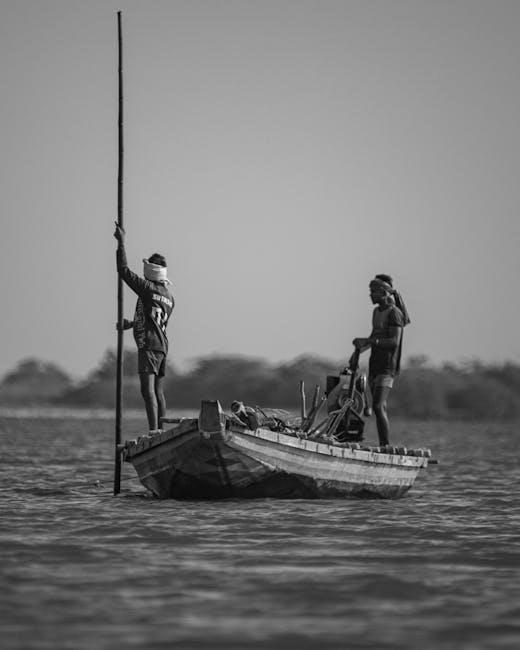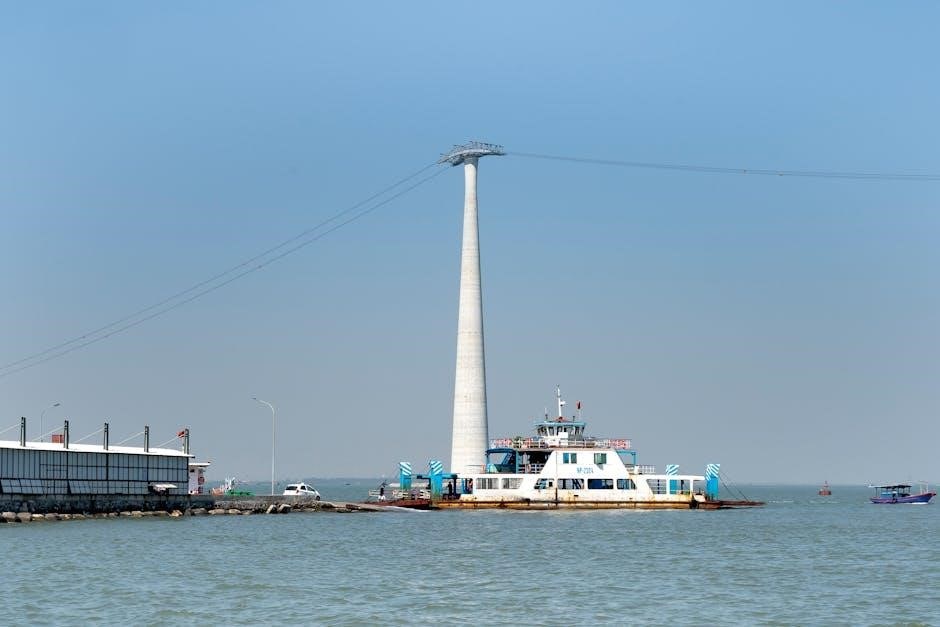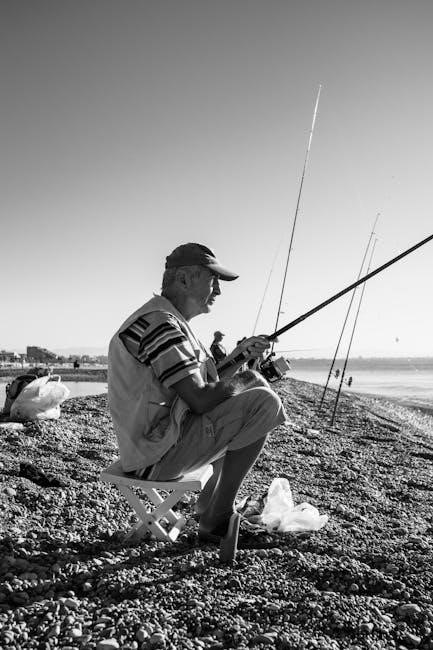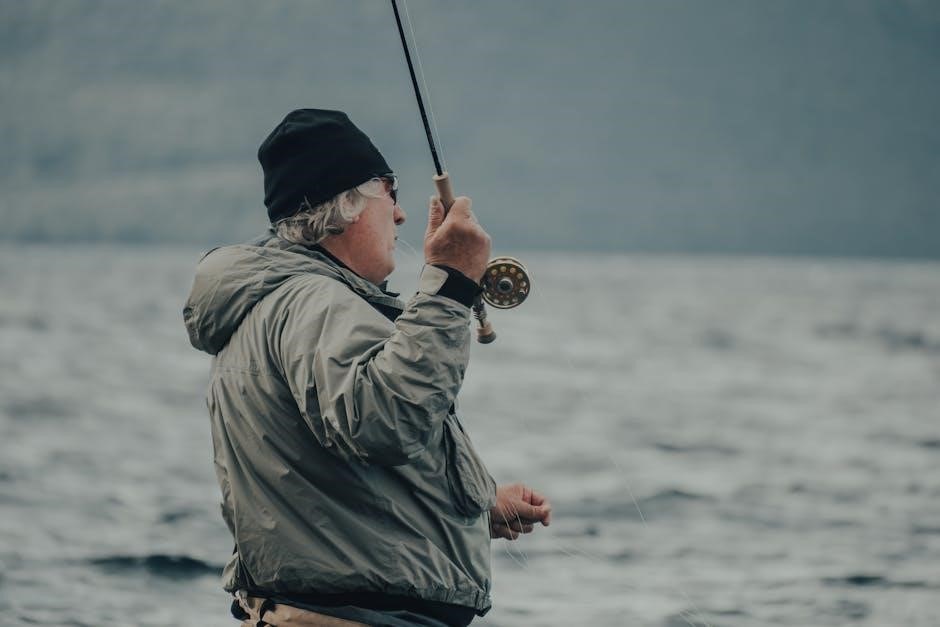Choosing the right fishing pole length is crucial for optimal performance and a successful fishing experience. This guide explores the factors influencing pole length.
Understand how pole length impacts casting, sensitivity, and control, helping anglers make informed decisions for various fishing techniques and environments.

Understanding the Importance of Fishing Pole Length
Fishing pole length significantly impacts performance, affecting casting distance, accuracy, and sensitivity. The right length enhances control, ensuring a more efficient and enjoyable fishing experience.
How Pole Length Affects Fishing Performance
Fishing pole length directly influences casting distance, accuracy, and sensitivity. Longer poles enhance casting range and leverage for larger fish, while shorter poles improve precision in tight spaces. Proper length ensures better control and reduces fatigue, optimizing overall performance.
- Longer poles excel in open water and for targeting bigger species.
- Shorter poles are ideal for tight spaces and delicate presentations.
- Incorrect length can hinder casting efficiency and fishing success.
Common Myths About Fishing Pole Length
Several misconceptions surround fishing pole length, often leading to poor choices. One common myth is that longer poles are always better, but this depends on the fishing scenario. Another myth is that a single pole length suits all fishing types, which is untrue. Some anglers believe pole length doesn’t affect species targeting, but it does impact leverage and control for different fish sizes. Additionally, the idea that shorter poles lack sensitivity is incorrect, as modern materials maintain performance. Understanding these myths helps anglers make informed decisions tailored to their fishing needs.

Types of Fishing and Recommended Pole Lengths
Freshwater fishing typically uses poles between 5-8 feet, while saltwater fishing often requires longer poles, 9-12 feet. Fly fishing prefers shorter, 7-9 foot rods, and ice fishing uses ultra-short, 16-28 inch poles. Surf fishing demands the longest poles, 10-14 feet, for casting distance. Each type tailors pole length to specific needs and environments.
Freshwater Fishing Pole Lengths
Freshwater fishing pole lengths vary based on the technique and target species. For panfish and small trout, shorter poles (5-6 feet) provide precision and control. Medium-length poles (6-7 feet) are ideal for bass, walleye, and general freshwater fishing, offering a balance of casting distance and maneuverability; Longer poles (7-8 feet) are better for larger species like pike or muskie, allowing for stronger casts and more leverage. Ultra-light rods (4-5 feet) are great for sensitive bites and small fish, while longer rods (8-10 feet) are used in specialty techniques like surfcasting or trolling. Matching the pole length to the fishing style and environment ensures optimal performance and success.
Saltwater Fishing Pole Lengths
Saltwater fishing pole lengths vary significantly based on the fishing environment and target species. For inshore fishing in bays or estuaries, shorter rods (6-7 feet) are ideal for accuracy and control when targeting species like redfish or snook. Offshore fishing in open waters often requires longer rods (7-9 feet) to handle larger species such as tarpon or tuna, providing greater casting distance and leverage. Surf fishing from beaches or piers typically uses rods ranging from 9-12 feet to reach distant fish. Heavy-duty rods (10-15 feet) are used for deep-sea fishing or battling large pelagic species. The choice of pole length depends on the specific fishing technique, target species, and the strength required to land the fish effectively.
Fly Fishing Pole Lengths
Fly fishing pole lengths are designed to suit specific fishing conditions and techniques. Rods for small streams and panfish typically range from 6-7 feet, offering precision and control in tight spaces. Medium-length rods (8-9 feet) are versatile for general freshwater fishing, such as targeting trout or bass. Longer rods (9-10 feet) are ideal for larger species like salmon or steelhead, providing extra casting distance and leverage. In saltwater fly fishing, rods can reach up to 12 feet for casting heavy lines and battling strong fish. The length choice depends on the target species, water type, and the angler’s casting style, ensuring optimal performance and comfort during the fishing experience.
Ice Fishing Pole Lengths
Ice fishing poles are typically shorter and more compact than other types of fishing rods, ranging from 24 to 36 inches (2 to 3 feet) in length. This shorter length is ideal for the tight, confined spaces of ice fishing, allowing for better control and precision when jigging or setting hooks. The shorter rod also makes it easier to manage lighter lines and smaller lures commonly used in ice fishing. Additionally, the compact size reduces fatigue during long sessions on the ice. Ice fishing rods are designed to be highly sensitive, helping anglers detect even the lightest bites through the ice. They are often made of durable, flexible materials to withstand freezing temperatures and the rigors of ice fishing.
- Typical lengths: 24-36 inches (2-3 feet)
- Benefits: Improved control, reduced fatigue, and increased sensitivity
- Ideal for targeting species like trout, walleye, and panfish
Surf Fishing Pole Lengths
Surf fishing poles are typically longer than other types of fishing rods, ranging from 9 to 12 feet (2.7 to 3.6 meters) in length. This extended length allows anglers to cast further out into the surf, reaching fish that gather in deeper waters beyond the breaking waves. Longer rods also provide the leverage needed to handle larger species common in surf fishing, such as striped bass, bluefish, and sharks. The added length helps manage the strength and control required for casting in windy or rough conditions. Surf fishing rods are often made of durable materials like graphite or fiberglass to withstand the harsh coastal environment and the force of larger fish.
- Typical lengths: 9-12 feet (2.7-3.6 meters)
- Benefits: Greater casting distance, improved leverage, and durability
- Ideal for targeting larger species like striped bass, bluefish, and sharks

Factors Influencing the Choice of Fishing Pole Length
Fishing pole length is influenced by technique, target species, environment, and personal comfort. Longer poles suit casting distance, while shorter poles offer better control and portability.
Fishing Technique and Its Impact on Pole Length
Various fishing techniques significantly influence the choice of pole length. For instance, casting distance is enhanced with longer poles, making them ideal for surf or fly fishing. Conversely, shorter poles provide superior control, which is crucial for precision techniques like ice fishing or pan fishing. The action of the pole, whether fast or slow, also plays a role, affecting sensitivity and hook-setting power. Additionally, the type of fishing line and lures used can dictate the appropriate pole length, as heavier lines require sturdier, often longer rods. Balancing these factors ensures optimal performance for specific fishing methods and target species.
Target Species and Their Specific Requirements
The target species plays a pivotal role in determining the appropriate fishing pole length. Larger, stronger fish like tuna or marlin require longer, heavier-duty poles to manage their weight and fighting ability. In contrast, smaller species such as trout or panfish demand shorter, lighter poles for better control and sensitivity. The fish’s size and strength directly influence the pole’s required action and durability, ensuring effective hooking and landing. Additionally, the fishing environment and technique used for a specific species further refine pole length selection, optimizing performance for successful catches. Understanding these needs ensures anglers choose the right tool for their desired prey, enhancing overall fishing efficiency and success rates.
Environmental Conditions and Their Role
Environmental conditions significantly influence the choice of fishing pole length. Weather, water type, and location play crucial roles in determining the ideal pole length. For instance, in windy conditions, shorter poles are preferred for better control, while calmer environments allow for longer poles to increase casting distance. In fast-moving rivers, shorter poles are advantageous for managing strong currents, whereas in still or deep waters, longer poles enhance reach and accuracy. Additionally, the type of water—freshwater, saltwater, or ice—impacts pole length due to varying gear requirements and fish behavior. Understanding these environmental factors ensures anglers select the optimal pole length for their specific fishing scenario, improving overall performance and efficiency. This adaptability is key to successful and enjoyable fishing experiences.

How to Choose the Right Fishing Pole Length
Selecting the right fishing pole length involves considering your fishing technique, target species, and environmental conditions to ensure optimal performance and comfort during your fishing trips.
Determining the Right Length for Your Needs
Determining the ideal fishing pole length starts with assessing your fishing style and environment. For beginners, shorter poles (5-6 feet) offer better control and ease of handling. Experienced anglers may prefer longer poles (7-9 feet) for increased casting distance and leverage. Consider the type of fishing—freshwater, saltwater, or specialized techniques like fly or ice fishing. Each requires specific lengths to optimize performance. Additionally, personal comfort plays a role; taller anglers may benefit from longer poles for better reach. Evaluate your target species as well, as larger fish demand sturdier, longer rods. By aligning these factors, you can choose a pole that enhances your fishing experience.
Considering Personal Comfort and Preference
Personal comfort and preference significantly influence the choice of fishing pole length. Taller anglers often prefer longer poles for better reach and leverage, while shorter individuals may find shorter poles more manageable. Consider your strength and stamina; lighter, shorter poles are ideal for those with less physical strength. Comfort during long fishing sessions is crucial, so ensure the pole feels balanced and easy to handle. Additionally, personal preference for action (flexibility) and material (graphite, fiberglass, or composite) plays a role. Some anglers prefer faster action for sensitivity, while others opt for slower action for more forgiving performance. Testing different lengths and styles can help you find the perfect fit for your needs and fishing style.
Location-Specific Pole Length Considerations
The fishing location significantly impacts the ideal pole length. For instance, in tight freshwater spaces like ponds or dense forests, shorter poles (5-6 feet) are more practical for maneuverability. Conversely, open water environments like lakes or oceans often require longer poles (7-9 feet) for extended casting range and better leverage. Saltwater surf fishing may demand even longer poles (10-12 feet) to reach distant fish. Ice fishing typically uses shorter, sturdier poles (2-3 feet) due to confined spaces and heavy gear. Additionally, portability and ease of transport in remote areas may influence your choice. Always adapt your pole length to the terrain and water conditions for the best results. Adjusting to the environment ensures efficiency and enhances your fishing experience.
Maintenance and Storage of Fishing Poles
Regularly clean your pole with a soft cloth and mild soap to prevent dirt buildup. Store it in a dry place, using a protective case or sleeve.
How to Properly Measure and Clean Your Pole
To measure your fishing pole accurately, extend it fully and use a flexible tape measure along the shaft from tip to butt. Clean the pole with a soft cloth and mild soap, avoiding harsh chemicals. Rinse thoroughly and dry to prevent rust or damage. Regularly inspect guides and ferrules for dirt or debris, using a small brush to remove particles. Store the pole in a dry place to maintain its integrity and performance. Proper maintenance ensures longevity and optimal fishing experiences. Always handle the pole with care to avoid scratches or breaks. Regular cleaning and inspections are essential for preserving your fishing pole’s condition and functionality over time.
Storage Tips to Maintain Pole Length and Integrity
Store your fishing pole in a cool, dry place to prevent moisture damage and rust. Use a protective case or sleeve to shield it from scratches and dust. Avoid extreme temperatures, as they can weaken the materials. Do not store the pole in a coiled position for extended periods, as this may cause warping. Keep it away from heavy objects to prevent accidental damage. For telescopic poles, store them fully extended to maintain their shape. Regularly inspect the pole for any signs of wear or damage before and after storage. Proper storage ensures your fishing pole remains in optimal condition, preserving its length and integrity for future use.
Selecting the right fishing pole length is essential for a successful and enjoyable fishing experience. By understanding how length impacts performance, anglers can make informed decisions tailored to their specific needs. Whether fishing in freshwater, saltwater, or specialized settings like ice or surf fishing, the right pole length enhances casting accuracy, sensitivity, and control. Additionally, proper storage and maintenance practices ensure your pole remains in excellent condition. Remember, the perfect fishing pole length is a balance of personal comfort, technique, and environmental factors. Use this guide to optimize your fishing gear and elevate your skills for memorable adventures on the water.
